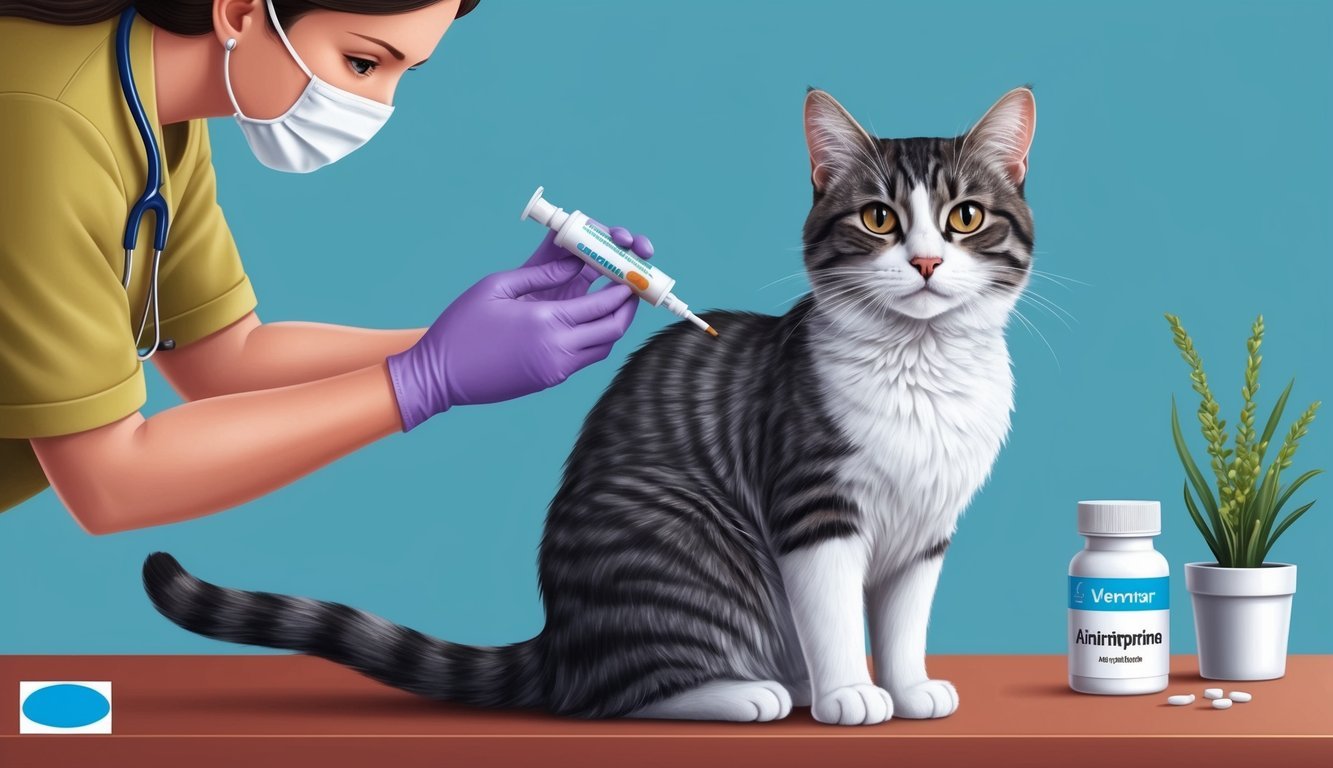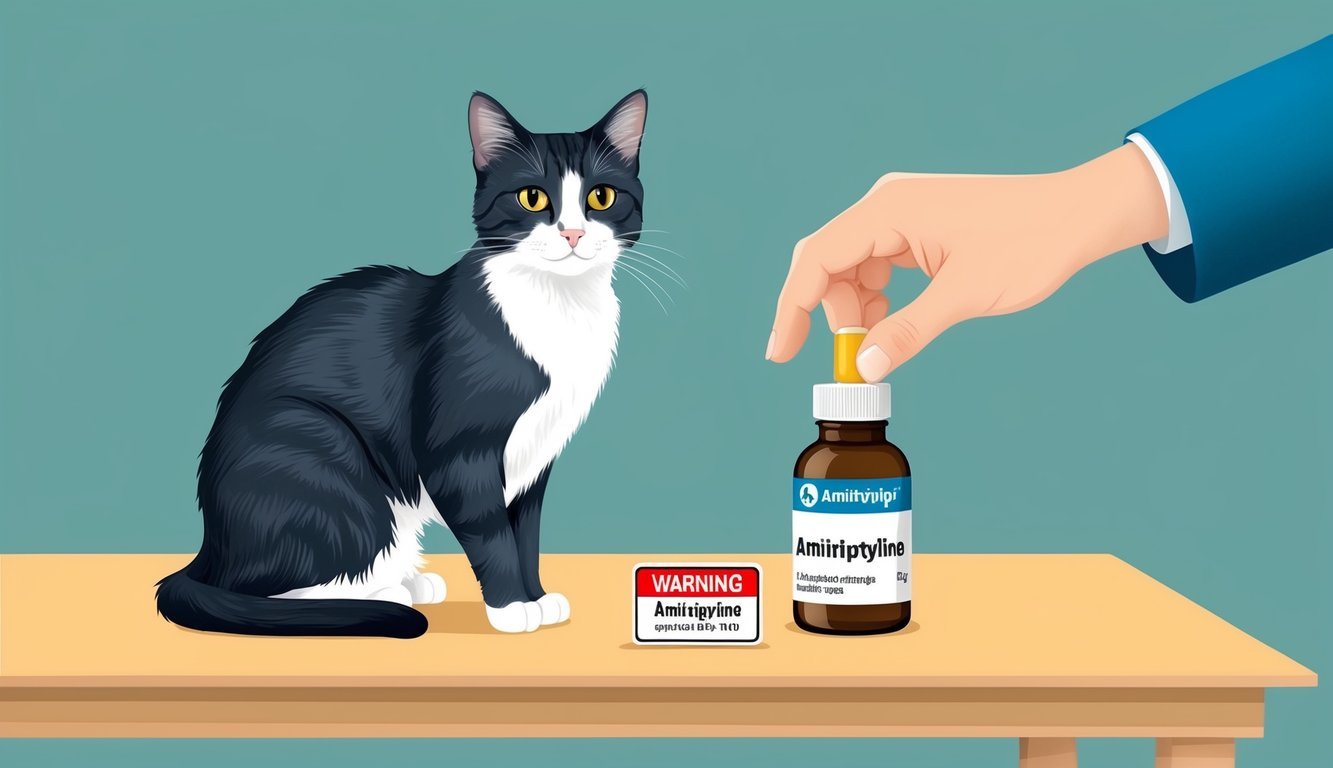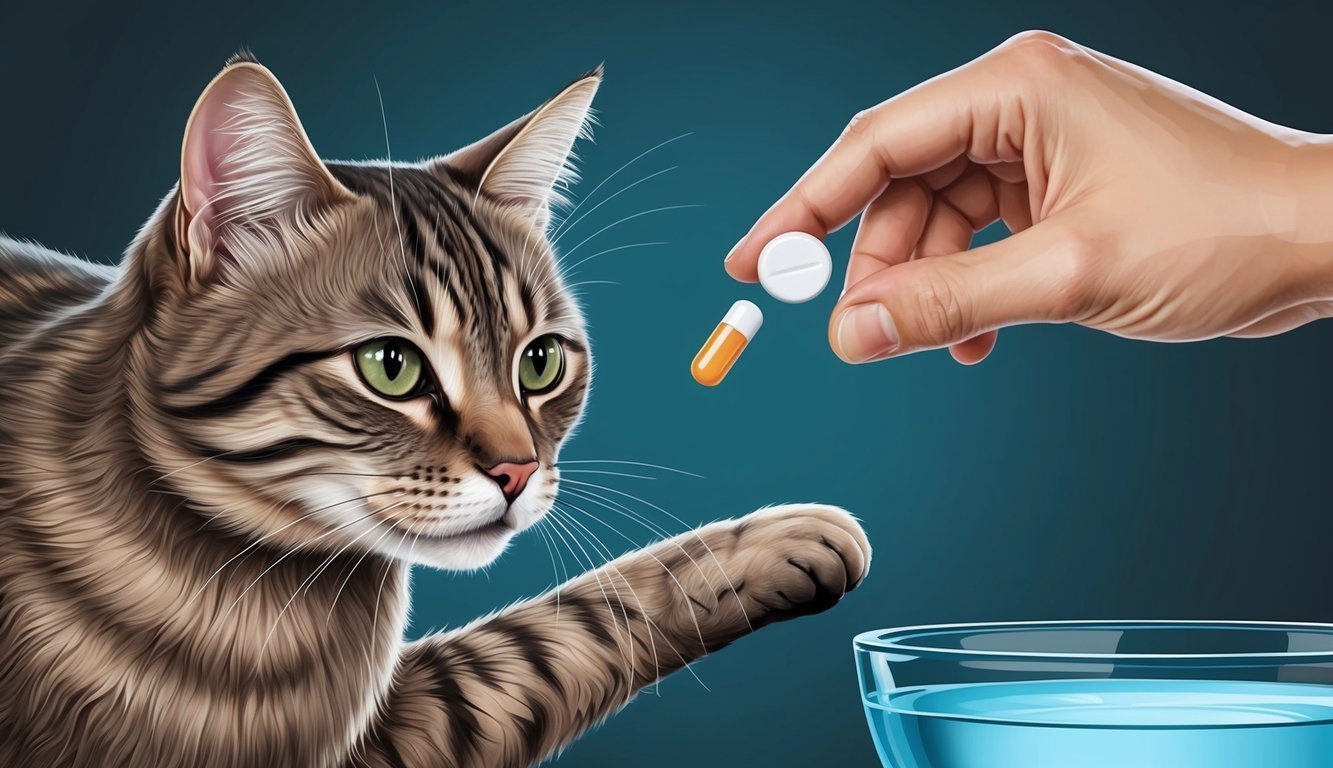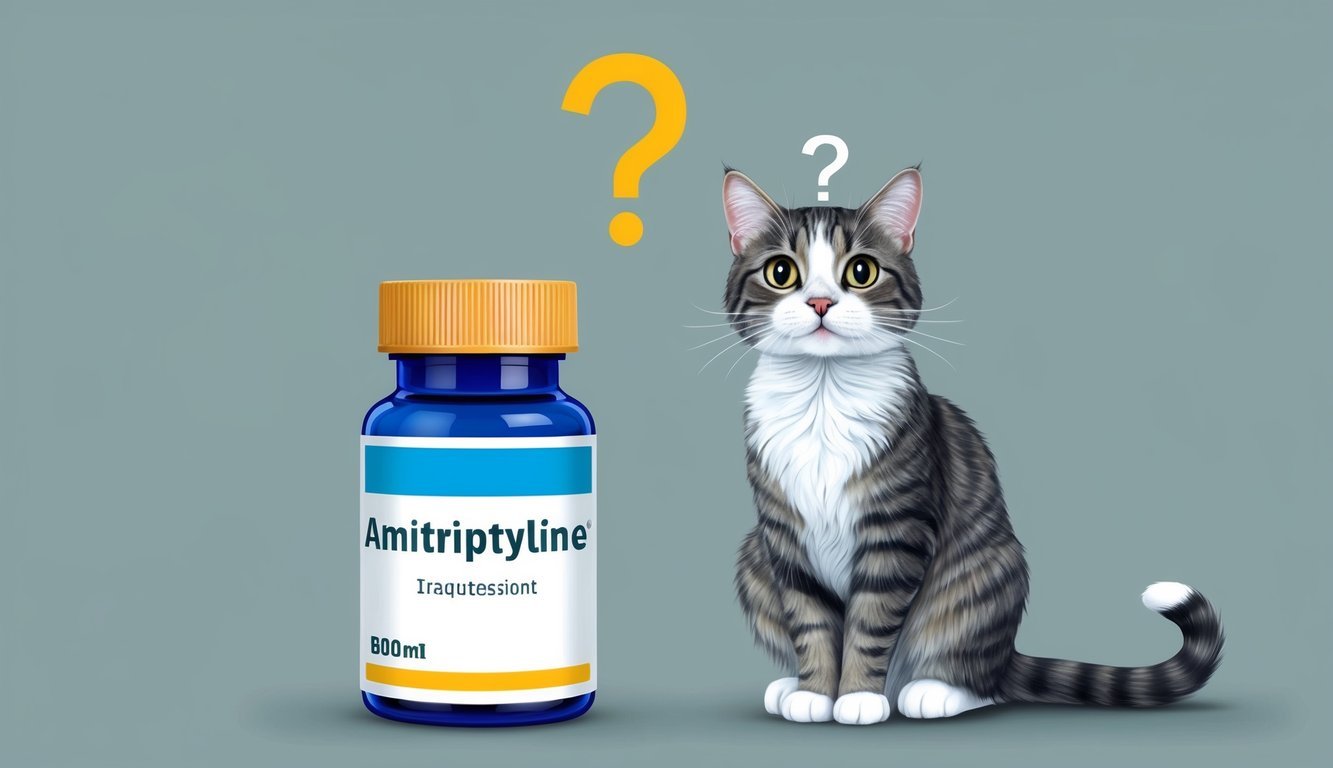Amitriptyline is often recognized for its use in humans, but did you know it can also be beneficial for your feline companions? This medication is effective in treating various behavioral disorders, chronic pain, and anxiety in cats.
Many pet owners find themselves puzzled when their cats exhibit stress-related issues or chronic discomfort, and understanding how amitriptyline can help is essential for providing the right care.
This tricyclic antidepressant works by altering certain chemical levels in the brain, which can lead to improved behavior and overall well-being.
From tackling anxiety and aggression to easing nerve pain, amitriptyline serves as a versatile option in veterinary medicine.
However, you must be aware of proper dosage and potential side effects to ensure your cat’s safety.
By exploring the effectiveness of amitriptyline in cats, you can better equip yourself to make informed decisions about your furry friend’s health.
Knowledge about what this medication can do and how to administer it safely will empower you in managing your pet’s needs.
Key Takeaways
- Amitriptyline can treat anxiety, aggression, and chronic pain in cats.
- Proper dosage and monitoring are vital for safety and effectiveness.
- Understanding potential side effects helps in managing your cat’s health.
Understanding Amitriptyline
Amitriptyline is primarily used as a tricyclic antidepressant for both humans and animals.
Its unique mechanism of action affects specific neurotransmitters in the brain, offering therapeutic benefits that help manage various behavioral issues in cats.
Chemical Nature and Mechanism of Action
Amitriptyline falls under the category of tricyclic antidepressants (TCAs).
It works by inhibiting the reabsorption of key neurotransmitters such as serotonin and norepinephrine.
When these neurotransmitters are blocked from reabsorption, they remain in the synaptic space longer, enhancing mood and providing relief from anxiety and depression.
This mechanism also impacts pain perception, making it useful for managing chronic pain and behavioral disorders in your cat.
Amitriptyline as a Tricyclic Antidepressant
As a TCA, amitriptyline differs from other classes of antidepressants like selective serotonin reuptake inhibitors (SSRIs).
While SSRIs target only serotonin, amitriptyline affects both serotonin and norepinephrine, which can offer a broader range of effects.
This broad action can lead to improved mood, reduced anxiety, and decreased occurrence of harmful behaviors such as excessive grooming or urine marking.
For cats, proper dosage is crucial to minimize potential side effects, which may include sedation and hypersalivation.
Off-Label Use in Veterinary Medicine
Amitriptyline is commonly prescribed off-label in veterinary settings to address behavioral issues in cats and dogs.
While initially developed for human use, veterinarians recognize its efficacy in treating feline anxiety, depression, and aggression.
Your veterinarian may prescribe amitriptyline to help with conditions like separation anxiety or anxiety-related behaviors, such as inappropriate urination.
It’s important to discuss your cat’s specific needs and any concerns you have about side effects with your vet to ensure the best treatment approach.
Medical Uses for Cats

Amitriptyline is primarily utilized in veterinary medicine to address a range of health issues in cats.
It plays a significant role in managing behavioral disorders, alleviating chronic pain, and easing symptoms of urinary tract diseases.
Treating Behavioral Disorders
Amitriptyline is commonly prescribed for cats with behavioral issues such as anxiety, excessive grooming, or aggression.
It works by increasing serotonin and norepinephrine levels, which are critical for mood regulation.
- Common conditions treated:
- Anxiety
- Fear-based behaviors
- Compulsive disorders
Veterinarians may consider this medication when traditional behavioral modifications fail.
Since it is used off-label for these issues, you may need to monitor your cat closely for any changes.
Managing Chronic Pain and Inflammation
Aside from behavioral management, amitriptyline can be effective for managing chronic pain, particularly neuropathic pain.
Conditions such as interstitial cystitis or arthritis may require a multifaceted approach.
- Benefits of using amitriptyline:
- Reduces pain perception
- Anti-inflammatory properties
Your veterinarian might prescribe amitriptyline to help your cat cope with ongoing discomfort.
Regular check-ins will ensure that the dosage is appropriate and effective.
Easing Symptoms of Feline Lower Urinary Tract Disease
Feline Lower Urinary Tract Disease (FLUTD) can significantly impact your cat’s well-being.
Amitriptyline may help reduce stress-related urinary issues, making it useful in managing symptoms.
- FLUTD symptoms that may improve:
- Frequent urination
- Urine spraying
- Straining to urinate
Veterinarians often recommend this treatment in conjunction with behavioral therapy, especially if stress is a contributing factor.
It’s essential to consult with your vet about a tailored treatment plan for your furry friend.
Dosage and Administration
When treating your cat with amitriptyline, understanding the correct dosage and administration methods is crucial.
Proper usage helps minimize side effects and ensures effective treatment of behavioral disorders.
Determining the Proper Dosage
Your veterinarian is the best resource for determining the appropriate dosage of amitriptyline for your cat.
The typical starting dosage is usually low, often around 1-2 mg per kg of body weight, but this can vary based on your cat’s specific needs.
Dosages may need adjustment based on your cat’s response or any side effects experienced.
Regular follow-ups with your vet can help monitor these changes.
Additionally, bloodwork may be recommended before starting treatment to ensure your cat’s overall health and evaluate kidney and liver function.
Methods of Administration
Amitriptyline can be administered in several ways, depending on what you and your veterinarian decide is best for your cat.
It’s often given as oral tablets, which can be easier for many cat owners.
Make sure to provide it with food to reduce stomach upset.
If your cat is resistant to taking pills, liquid formulations might be available.
Always follow your veterinarian’s advice on how to administer the medication correctly.
If you’re having difficulty, consider consulting your vet for tips or alternative methods.
Importance of Following Veterinary Guidance
Following your veterinarian’s guidance is essential throughout the treatment process.
They will provide specific instructions tailored to your cat’s health needs.
Your vet may adjust the dosage based on your cat’s progress and any side effects.
Consistent communication regarding your cat’s behavior and health status can facilitate necessary adjustments.
Never attempt to alter the dosage without consulting your veterinarian first.
This ensures the medication remains effective and safe for your cat.
Potential Side Effects

When considering amitriptyline for your cat, it’s essential to be aware of the potential side effects that may arise.
Monitoring your pet closely can help manage these effects effectively.
Recognizing Common Side Effects
Many cats tolerate amitriptyline well, but some common side effects may still appear.
You might notice your cat experiencing:
- Drowsiness or sedation: This is one of the most frequently reported effects, leading your cat to appear lethargic or less active than usual.
- Increased appetite: Amitriptyline can stimulate your cat’s appetite, possibly resulting in weight gain over time.
- Dry mouth: This can lead to discomfort, so keep an eye on your cat’s drinking habits.
- Constipation: Changes in bowel movements may occur, so monitor your cat for signs of straining or discomfort.
Being proactive about these common side effects can ensure your cat remains comfortable while on the medication.
Understanding Serious Adverse Reactions
While most side effects are mild, serious reactions can occur, although they are less common.
If you observe any of the following, it’s crucial to contact your veterinarian immediately:
- Vomiting: Frequent or severe vomiting can lead to dehydration and requires evaluation.
- Urinary retention: If your cat struggles to urinate, seek veterinary assistance promptly to prevent serious complications.
- Disorientation or confusion: Signs may include wandering aimlessly or not responding to familiar cues.
- Allergic reactions: Symptoms like itchiness, swelling, or difficulty breathing warrant urgent care.
Recognizing these serious signs can help you react quickly, ensuring your cat’s safety.
Side Effects Specific to Feline Physiology
Cats metabolize drugs differently than humans or dogs, leading to unique side effects.
A few specific concerns include:
- Weight gain: Due to increased appetite, monitor your cat’s weight closely as obesity can lead to further health issues.
- Dehydration: Dry mouth may cause your cat to drink less. Keep fresh water accessible to encourage hydration.
- Lethargy: Cats may naturally sleep a lot, but if you notice excessive tiredness, it could be a response to the medication.
- Itchiness: While not everyone experiences this, itchy skin can occur, prompting excessive grooming and discomfort.
Being informed about these side effects can help you take better care of your feline companion.
Safety Precautions and Contraindications

Amitriptyline can be beneficial for cats, but it’s essential to consider the specific health conditions and interactions that could impact safety.
You should stay informed about potential risks that could arise from underlying medical issues and the consequences of drug interactions.
Regular monitoring is crucial to ensure your cat remains safe throughout treatment.
Risks Associated with Medical Conditions
Before starting amitriptyline, discuss your cat’s health history with your veterinarian.
Conditions like kidney disease, liver disease, heart rhythm disorders, and hyperthyroidism can elevate the risk of complications.
- Kidney Disease: If your cat has kidney issues, amitriptyline’s elimination from the body may be impaired, leading to an increased risk of side effects.
- Liver Disease: Liver function needs to be checked, as the medication is metabolized in the liver. Impaired liver function can lead to elevated drug levels.
- Heart Rhythms: Cats with existing heart rhythm problems may experience exacerbated symptoms. An ECG may be recommended to monitor heart health.
Drug Interactions and Complications
Amitriptyline can interact with various medications, posing risks to your cat’s health.
Always inform your veterinarian about any other treatments your cat is receiving.
Potential drug interactions include:
- MAO Inhibitors: These can lead to severe reactions.
- Other CNS Depressants: Using amitriptyline alongside other sedatives could result in excessive drowsiness.
- Thyroid Medications: If your cat is being treated for hyperthyroidism, it may alter how amitriptyline works.
It’s essential to assess these risks before starting treatment to provide safe and effective care.
Monitoring and Regular Check-Ups
Regular check-ups are a crucial part of ensuring your cat’s safety while on amitriptyline.
Bloodwork should be conducted initially, and periodically thereafter, to monitor liver and kidney function.
- Keep an eye on behavior changes, sedation levels, and any signs of adverse reactions.
- Communicate with your veterinarian about any health changes.
This proactive approach allows for timely adjustments to dosage or treatment if necessary.
Your veterinarian may also track your cat’s ECG results to monitor heart health throughout the treatment.
Care and Management

Managing a cat on amitriptyline involves attention to behavioral training, readiness for emergencies, and considerations for long-term health.
These aspects are crucial to ensure that your feline friend remains comfortable, happy, and healthy.
Incorporating Behavioral Training
Effective behavioral training can significantly improve your cat’s adjustment to amitriptyline.
Start by identifying specific behavioral issues, like separation anxiety or inappropriate elimination.
Use positive reinforcement methods, rewarding your cat for desired behaviors.
This can include treats, praise, or playtime.
Consistency in training sessions helps reinforce learning.
Consider consulting a veterinarian or a professional animal behaviorist for tailored strategies.
They may suggest specialized training programs or resources to address specific challenges.
Handling Emergency Situations
Being prepared for potential emergencies is vital.
While side effects of amitriptyline are generally manageable, knowing when to seek veterinary help is essential.
Watch for signs like excessive sedation, seizures, or any unusual behaviors.
Keep your veterinarian’s contact information readily available.
If your cat displays severe symptoms, do not hesitate to call your vet immediately.
Having a first-aid kit specific to pets can also be beneficial.
Include items like gauze, antiseptic wipes, and any medications your cat may require.
Long-Term Considerations for Feline Health
Long-term health is a critical consideration when administering amitriptyline.
Regular veterinary check-ups will help monitor your cat’s response to the medication and any potential side effects.
Discuss any underlying medical conditions with your vet, especially related to Feline Lower Urinary Tract Disease (FLUTD).
Balance medication with other treatments, like dietary adjustments or supplemental therapies.
Be aware of your cat’s behavior and make note of any changes.
Keeping a journal can help track progress or issues over time.
This way, you’ll have valuable information to share with your veterinarian during visits.
Additional Information
When managing your cat’s treatment with amitriptyline, it’s important to follow proper storage guidelines and consider alternative treatments available.
Here’s what you need to know.
Storage Guidelines and Safety
Proper storage of amitriptyline is essential to ensuring its effectiveness.
Store the medication in a cool, dry place, away from direct sunlight. Avoid humidity; a bathroom cabinet is typically not ideal due to moisture.
Keep the medication in its original container, tightly closed, and out of reach of pets and children.
Check expiration dates regularly.
Discard any expired medications properly, following your local guidelines.
If your cat experiences unusual side effects, like excessive sedation or drooling, contact your veterinarian immediately for advice.
Considering Alternative Treatments
While amitriptyline (Elavil, Levate) is effective for certain behavioral issues, you might explore alternative treatments as well.
Non-prescription options like antihistamines can sometimes help with anxiety and other mild issues, but always consult your veterinarian first.
Alternative therapies like behavioral modification or environmental enrichment can also benefit your cat by reducing stressors.
For serious concerns that amitriptyline doesn’t address, your vet may recommend different medications or strategies.
Always discuss any adjustments with your veterinarian to ensure your cat’s safety and well-being.
Frequently Asked Questions

When considering amitriptyline for your cat, you likely have several important questions.
Understanding dosage, potential side effects, administration methods, and behavioral changes can help you manage your cat’s treatment effectively.
What is the proper dosage of amitriptyline for cats with anxiety?
The proper dosage of amitriptyline for anxiety in cats typically ranges from 0.5 to 2 mg per kilogram of body weight, administered once daily.
It’s crucial to follow your veterinarian’s specific recommendations, as individual needs may vary based on your cat’s health and condition.
Can amitriptyline cause side effects in feline patients?
Yes, amitriptyline can cause side effects in cats.
Common side effects include sedation, dry mouth, and constipation.
Although these effects are generally manageable, report any unusual behaviors or extreme fatigue to your vet.
How can I effectively administer amitriptyline to my cat?
To administer amitriptyline, you can give it in pill form or as a liquid.
If your cat resists taking pills, hiding the medication in food or using a pill pocket might help.
Consistency in timing helps maintain the medication’s effectiveness.
What types of behaviors in cats may indicate that amitriptyline is having a positive effect?
You may notice reduced anxiety-related behaviors, such as less hiding or fewer vocalizations.
Additionally, your cat might show improved social interactions or a decrease in litter box issues related to stress.
Are there any known interactions between amitriptyline and other medications in cats?
Yes, amitriptyline can interact with other medications, such as certain anti-anxiety drugs or antidepressants.
Always inform your veterinarian about any other medications or supplements your cat is taking to prevent adverse reactions.
How does amitriptyline help manage inappropriate urination in cats?
Amitriptyline helps manage inappropriate urination by addressing underlying anxiety or stress, which are common triggers.
It can reduce the urge to urinate outside the litter box by calming your cat, leading to improved behavior over time.

